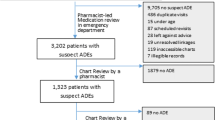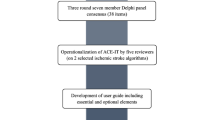Abstract
Background
Clinical trials are needed to study topics relevant to older adults with serious illness. Investigators conducting clinical trials with this population are challenged by how to appropriately define, classify, report, and monitor serious and non-serious adverse events (SAEs/AEs), given that some traditionally reported AEs (pressure ulcers, delirium) and SAEs (death, hospitalization) are common in persons with serious illness, and may be consistent with their goals of care.
Objectives
A multi-stakeholder group convened to establish greater clarity on and new approaches to address this critical issue.
Participants
Thirty-two study investigators, members of regulatory and sponsor agencies, and patient stakeholders took part.
Approach
The group met virtually four times and, using a collaborative approach, conducted a survey, select interviews, and reviewed regulatory guidance to collectively define the problem and identify a new approach.
Results
SAE/AE challenges fell into two areas: (1) definitions and classifications, including (a) implausible relationships, (b) misalignment with patient-centered care goals, and (c) well-known associations, and (2) reporting and monitoring, including (a) limited guidance, (b) inconsistent standards across regulators, and (c) Data Safety Monitoring Board (DSMB) member knowledge gaps. Problems largely reflected practice norms rather than regulatory requirements that already support context-specific and aggregate reporting. Approaches can be improved by adopting principles that better align strategies for addressing adverse events with the type of intervention being tested, favoring routine and aggregate over expedited reporting, and prioritizing how SAE/AEs relate to patient-centered care goals. Reporting plans and decisions should follow an algorithm underpinned by these principles.
Conclusions
Adoption of the proposed approach—and supporting it with education and better alignment with regulatory guidance and procedures—could improve the quality and efficiency of clinical trials’ safety involving older adults with serious illness and other vulnerable populations.

Similar content being viewed by others
References
Kelley AS. Defining ‘serious illness’. J Palliat Med. 2014;17(9). doi: https://doi.org/10.1089/jpm.2014.0164
Kelley AS, Covinsky KE, Gorges RJ, et al. Identifying older adults with serious illness: a critical step toward improving the value of health care. Health Serv Res. 2017;52(1):113-131. doi: https://doi.org/10.1111/1475-6773.12479
Committee on Approaching Death: Addressing Key End of Life Issues, Institute of Medicine. Dying in America: Improving Quality and Honoring Individual Preferences Near the End of Life. Washington DC: National Academies Press; 2015.
National Academies of Sciences E. Families Caring for an Aging America; 2016. doi:https://doi.org/10.17226/23606.
National Academies of Sciences E. Policy and Research Needs to Maximize Independence and Support Community Living: Workshop Summary; 2016. doi:https://doi.org/10.17226/21893
Institute of Medicine. Integrating Health Care and Social Services for People with Serious Illness: Proceedings of a Workshop. www.nationalacademies.org/hmd/Reports/2019/integrating-healthcare-and-social-services-for-people-with-serious-illness-proceedings.aspx, accessed 11/16/2021.
Institute of Medicine. Cognitive Aging: Progress in Understanding and Opportunities for Action; 2015. doi:https://doi.org/10.17226/21693.
NIH State-of-the-Science Conference Statement on improving end-of-life care. NIH Consens State Sci Statements. 2004;21(3):1-26.
National Institutes of Health. NIH Policy for Data and Safety Monitoring. 1998. https://grants.nih.gov/grants/guide/notice-files/not98-084, accessed 11/2/2021, accessed 11/2/2021.
Califf R. Clinical trials bureaucracy: unintended consequences of well-intentioned policy. Clin Trials 2006; 3: 496–502. doi: https://doi.org/10.1177/1740774506073173
Levit L, et al. Streamlining adverse events reporting in oncology: An American Society of Clinical Oncology Research Statement. J Clin Oncol. 2018;36(6). doi: https://doi.org/10.1200/JCO.2017.75.8193
George G, et al. Improving attribution of adverse events in oncology clinical trials. Cancer Treat Rev. 2019;76. doi: https://doi.org/10.1016/j.ctrv.2019.04.004
Cook D, et al. Serious adverse events in academic critical care research. Can Med Assoc J. 2008;178(9). doi: https://doi.org/10.1503/cmaj.071366
Reith C, et al. Randomized clinical trials — removing unnecessary obstacles. NEJM. 369;11: 1061-1065. doi: https://doi.org/10.1056/NEJMsb1300760
Czaja S, et al. Data and safety monitoring in social behavioral intervention trials: the REACH II experience. Clin Trials J. 2006;3(2). doi: https://doi.org/10.1191/1740774506cn136oa
Vose, et al. Addressing Administrative and Regulatory Burden in Cancer Clinical Trials: Summary of a Stakeholder Survey and Workshop Hosted by the American Society of Clinical Oncology and the Association of American Cancer Institutes. J Clin Onc. 2016; 34(31). doi: https://doi.org/10.1200/JCO.2016.69.6781
Halpern S, Temel J, Courtright K. Dealing with death as an outcome in supportive care clinical trials. JAMA Intern Med. 2021;181(7). doi: https://doi.org/10.1001/jamainternmed.2021.1816
D’Amour D, et al. The conceptual basis for interprofessional collaboration: core concepts and theoretical frameworks. J Interprof Care. 2005; 19;Suppl 1:116-31. doi: https://doi.org/10.1080/13561820500082529
Peterson A, et al. The need for expanded monitoring of adverse events in behavioral health clinical trials. Cont Clin Trials. 2012;34(1):152-4. doi: https://doi.org/10.1016/j.cct.2012.10.009
Nebeker J, Barach P, Samore M. Clarifying adverse drug events: a clinician's guide to terminology, documentation, and reporting. Ann Intern Med. 2004;140(10):795-801. doi: https://doi.org/10.7326/0003-4819-140-10-200405180-00009
Federal Drug Administration. 21 CFR 312.32(a). https://www.accessdata.fda.gov/scripts/cdrh/cfdocs/cfcfr/cfrsearch.cfm?fr = 312.32, accessed 11/4/2021.
Higginson IJ, et al. Project PRISMA. Priorities for treatment, care and information if faced with serious illness: a comparative population-based survey in seven European countries. Palliat Med. 2014;28(2):101-10. doi: https://doi.org/10.1177/0269216313488989
Teno JM, Fisher ES, Hamel MB, et al. Medical Care Inconsistent with Patients' Treatment Goals: Association with 1-Year Medicare Resource Use and Survival. J Am Ger Soc. 2002;50: 496-500. doi: https://doi.org/10.1046/j.1532-5415.2002.50116.x
Infectious Diseases Society of America. Grinding to a Halt: The effects of the increasing regulatory burden on research and quality improvement efforts. CID;2009:49.
DeMets D, Ellenberg S. Data Monitoring Committees — Expect the Unexpected. NEJM. 2016. doi: https://doi.org/10.1056/NEJMra1510066
Eapen Z, et al. Rescuing clinical trials in the United States and beyond: A call for action. Am Heart J 2013; 165:837-47. doi: https://doi.org/10.1016/j.ahj.2013.02.003
NIA Guidance on Clinical Trials. http://www.nia.nih.gov/research/grants-funding/nia-guidance-clinical-trial, accessed 11/4/2021.
Reviewing and Reporting Unanticipated Problems Involving Risks to Subjects or Others and Adverse Events: OHRP Guidance 2007. http://www.hhs.gov/ohrp/regulations-and-policy/guidance/reviewing-unanticipated-problems/index.html, accessed 9/23/2021.
Serious Adverse Event/Unanticipated Problem Decision Tree for Principal Investigators. https://www.nia.nih.gov/sites/default/files/2020-12/AE-SAE-Process-Chart_Dec2020.pdf, Accessed 9/23/2021.
Morrison RS, et al. The Hard Task of Improving the Quality of Care at the End of Life. 2000. JAMA;160. doi: https://doi.org/10.1001/archinte.160.6.743
CTTI Recommendations: Data Monitoring Committees. https://ctti-clinicaltrials.org/wp-content/uploads/2021/06/CTTI_DMC_Recs.pdf, accessed 9/23/2021.
Naranjo CA, Busto U, Sellers EM, et al. A method for estimating the probability of adverse drug reactions. Clin Pharmacol Ther. 1981;30:239-45. doi: https://doi.org/10.1038/clpt.1981.154
Childress J. The Place of Autonomy in Bioethics. 1990. The Hastings Center Report. 20(1).
Stange K, et al. Defining and measuring the patient-centered medical home. J Gen Intern Med. 2010;25(6). doi: https://doi.org/10.1007/s11606-010-1291-3.
Acknowledgements
We would like to acknowledge the full convening group for their significant collective contribution to the development of the ideas presented in this manuscript, and in particular Abby Archer who provided administrative support for the convening. Individuals participating in the convening contributed personal opinions and were not expressing the views of their respective agencies and institutions. The convening and resulting manuscript was supported by an administrative supplement from the National Institutes on Aging U24AG059624 (Coordinating Center of the Claude D. Pepper Older Americans Independence Centers; PI: Kitzman). Additional support was provided by National Institutes on Aging P30AG028741 (Enhancing Independence in Elders with Serious Illness; PIs: Siu, Morrison) and the National Palliative Care Research Center (NPCRC). Some of the ideas included in this manuscript were presented at the American Academy of Hospice and Palliative Medicine 2022 State of the Science on February 12, 2022.
Author information
Authors and Affiliations
Corresponding author
Ethics declarations
Conflict of Interest
The authors declare that they do not have a conflict of interest.
Additional information
Publisher’s Note
Springer Nature remains neutral with regard to jurisdictional claims in published maps and institutional affiliations.
Rights and permissions
About this article
Cite this article
Baim-Lance, ., Ferreira, K.B., Cohen, H.J. et al. Improving the Approach to Defining, Classifying, Reporting and Monitoring Adverse Events in Seriously Ill Older Adults: Recommendations from a Multi-stakeholder Convening. J GEN INTERN MED (2022). https://doi.org/10.1007/s11606-022-07646-7
Received:
Accepted:
Published:
DOI: https://doi.org/10.1007/s11606-022-07646-7




